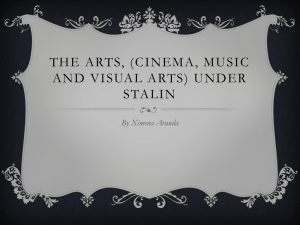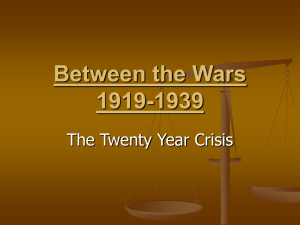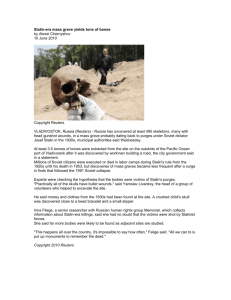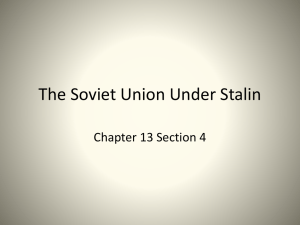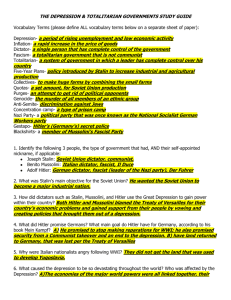Totalitarianism
advertisement
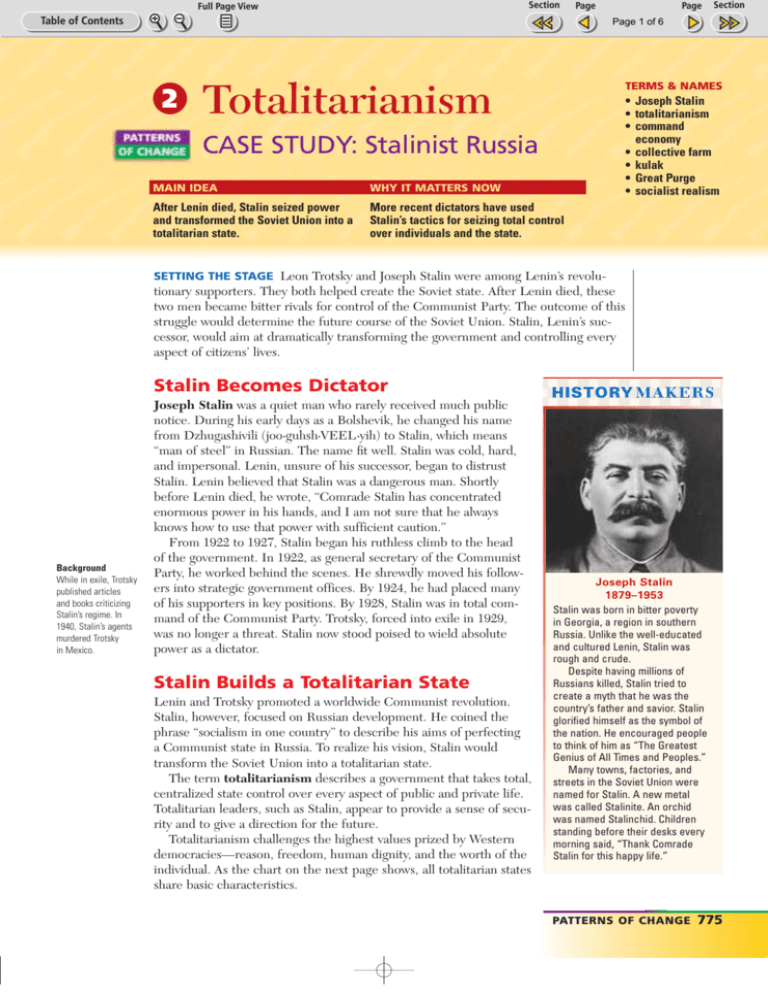
775-780-0730s2 10/11/02 4:51 PM 2 Page 775 Page 1 of 6 TERMS & NAMES Totalitarianism • Joseph Stalin • totalitarianism • command economy • collective farm • kulak • Great Purge • socialist realism CASE STUDY: Stalinist Russia MAIN IDEA WHY IT MATTERS NOW After Lenin died, Stalin seized power and transformed the Soviet Union into a totalitarian state. More recent dictators have used Stalin’s tactics for seizing total control over individuals and the state. SETTING THE STAGE Leon Trotsky and Joseph Stalin were among Lenin’s revolu- tionary supporters. They both helped create the Soviet state. After Lenin died, these two men became bitter rivals for control of the Communist Party. The outcome of this struggle would determine the future course of the Soviet Union. Stalin, Lenin’s successor, would aim at dramatically transforming the government and controlling every aspect of citizens’ lives. Stalin Becomes Dictator Joseph Stalin was a quiet man who rarely received much public notice. During his early days as a Bolshevik, he changed his name from Dzhugashivili (joo guhsh VEEL yih) to Stalin, which means “man of steel” in Russian. The name fit well. Stalin was cold, hard, and impersonal. Lenin, unsure of his successor, began to distrust Stalin. Lenin believed that Stalin was a dangerous man. Shortly before Lenin died, he wrote, “Comrade Stalin has concentrated enormous power in his hands, and I am not sure that he always knows how to use that power with sufficient caution.” From 1922 to 1927, Stalin began his ruthless climb to the head of the government. In 1922, as general secretary of the Communist Party, he worked behind the scenes. He shrewdly moved his followers into strategic government offices. By 1924, he had placed many of his supporters in key positions. By 1928, Stalin was in total command of the Communist Party. Trotsky, forced into exile in 1929, was no longer a threat. Stalin now stood poised to wield absolute power as a dictator. • Background While in exile, Trotsky published articles and books criticizing Stalin’s regime. In 1940, Stalin’s agents murdered Trotsky in Mexico. • ■ ■ ■ ■ ■ ■ ■ ■ ■ ■ ■HISTORY ■ ■ ■ ■MAKERS ■ ■ ■ ■ ■ ■ ■ ■ ■ ■ ■ ■ ■ ■ • Stalin Builds a Totalitarian State Lenin and Trotsky promoted a worldwide Communist revolution. Stalin, however, focused on Russian development. He coined the phrase “socialism in one country” to describe his aims of perfecting a Communist state in Russia. To realize his vision, Stalin would transform the Soviet Union into a totalitarian state. The term totalitarianism describes a government that takes total, centralized state control over every aspect of public and private life. Totalitarian leaders, such as Stalin, appear to provide a sense of security and to give a direction for the future. Totalitarianism challenges the highest values prized by Western democracies—reason, freedom, human dignity, and the worth of the individual. As the chart on the next page shows, all totalitarian states share basic characteristics. Joseph Stalin 1879–1953 Stalin was born in bitter poverty in Georgia, a region in southern Russia. Unlike the well-educated and cultured Lenin, Stalin was rough and crude. Despite having millions of Russians killed, Stalin tried to create a myth that he was the country’s father and savior. Stalin glorified himself as the symbol of the nation. He encouraged people to think of him as “The Greatest Genius of All Times and Peoples.” Many towns, factories, and streets in the Soviet Union were named for Stalin. A new metal was called Stalinite. An orchid was named Stalinchid. Children standing before their desks every morning said, “Thank Comrade Stalin for this happy life.” PATTERNS OF CHANGE 775 775-780-0730s2 10/11/02 4:51 PM Page 776 Page 2 of 6 PATTERNS OF CHANGE: Totalitarianism Key Traits Description Dictatorship and One-Party Rule • Exercises absolute authority • Dominates the government Dynamic Leader • Helps unite people toward meeting shared goals or realizing a common vision • Encourages people to devote their unconditional loyalty and uncritical support to the regime • Becomes a symbol of the government Ideology (set of beliefs) • Justifies government actions • Glorifies the aims of the state State Control Over All Sectors of Society • business • family life State Control Over the Individual • Demands total obedience to authority and personal sacrifice for the good of the state • Denies basic liberties Dependence on Modern Technology • Relies on mass communication, such as radios, newsreels, and loudspeakers, to spread propaganda • Builds up advanced military weapons Organized Violence • Uses force, such as police terror, to crush all opposition • Targets certain groups, such as national minorities and political opponents, as enemies • labor • youth groups • housing • religion • education • the arts S K I L L B U I L D E R : Interpreting Charts 1. Based on the chart, how are individuals in a totalitarian state molded into obedient citizens? 2. How would your life change if you lived in a totalitarian state? Other totalitarian governments besides the Soviet Union emerged in the twentieth century. In the 1920s and 1930s, two other European dictators—Hitler in Germany and Mussolini in Italy—were shaping their visions of a totalitarian state. After Communists formed the People’s Republic of China in 1949, Mao Zedong used tactics similar to Stalin’s to establish totalitarian control. The North Korean dictator Kim Il Sung ruled over a totalitarian Communist state from 1948 to 1994. By 1928 Stalin began taking great strides to build a totalitarian state. He had achieved personal power and was ready to begin overhauling the economy. CASE STUDY: Stalinist Russia Stalin Seizes Control of the Economy While Lenin’s New Economic Policy (NEP) was a mixture of free enterprise and state control, Stalin’s economic policies involved total state control. His plans called for a command economy—a system in which the government made all economic decisions. Under this system, political leaders identify the country’s economic needs and determine how to fulfill them. To modernize the Soviet state, Stalin ushered in revolutions in industry and agriculture. An Industrial Revolution In 1928, Stalin outlined the first of several Five-Year Plans for the development of the Soviet Union’s economy. The government would take drastic steps to promote rapid industrial growth and to strengthen national defense. Stalin announced, “We are fifty or a hundred years behind the advanced countries. We must make good this distance in ten years. Either we do it or we shall be crushed.” The Five-Year Plans set impossibly high quotas, or numerical goals, to increase the output of steel, coal, oil, and electricity. To reach these targets, the government limited production of consumer goods. As a result, people faced severe shortages of housing, food, clothing, and other necessary goods. 776 CHAPTER 30 The number of tractors in the Soviet Union increased from 25,000 in 1927 to 483,000 in 1938. Page 777 Under Stalin’s totalitarian regime, the government controlled every aspect of the worker’s life. Officials chose the workers, assigned them jobs, and determined their working hours. Workers needed the police’s permission to move. The secret police were ready to imprison or execute those who did not contribute to the Soviet economy. These forceful means of making the Soviet Union a modern industrial nation took a great toll on people’s personal lives. Many families and marriages broke up. Stalin’s grim methods, however, also produced fantastic economic results. Although most of the targets of the first Five-Year Plan fell short, the Soviets made impressive gains. A second plan, launched in 1933, proved equally successful. From 1928 to 1937, industrial production increased more than 25 percent. An Agricultural Revolution Stalin’s agricultural revolution was Background Many peasants had only recently won their own land. For centuries, they had struggled against the nobles. Now they were forced to submit to yet another landlord—the Soviet government. THINK THROUGH HISTORY A. Summarizing What methods did Stalin use to bring agriculture under state control? A. Possible Answer Establishment of collective farms; use of terror and violence; destruction of the kulaks Vocabulary purge: a systematic effort to eliminate a targeted group of people. also successful—and far more brutal—than his industrial revolution. In 1928, the government began to seize over 25 million privately owned farms in the USSR. It combined them into large, government-owned farms, called collective farms. Hundreds of families worked on these farms, producing food for the state. The government expected that the modern machinery on the collective farms would boost food production and reduce the number of workers. Peasants resisted fiercely. Many killed livestock and destroyed crops in protest. Stalin used terror and violence to force peasants to work on collective farms. Soviet secret police herded them onto collective farms at the point of a bayonet. Between 5 million and 10 million peasants died as a direct result of Stalin’s agricultural revolution. Millions more were shipped to Siberia. Resistance was especially strong among kulaks, a class of wealthy peasants. The Soviet government decided to eliminate them. Thousands were executed or sent to work camps. By 1938, more than 90 percent of all peasants lived on collective farms. Agricultural production was on the upswing. That year the country produced almost twice the wheat than it had in 1928 before collective farming. Page 3 of 6 The Buildup of the Soviet Economy INDUSTRY 150 Metric Tons (in millions) 4:51 PM ■ Coal Production 120 90 60 30 0 1928 1933 1st FiveYear Plan ■ Steel Production 1938 2nd FiveYear Plan AGRICULTURE 35 Animals (in millions) 10/11/02 30 25 20 ■ Livestock 15 10 1928 1933 1st FiveYear Plan 1938 2nd FiveYear Plan 50 Metric Tons (in millions) 775-780-0730s2 ■ Wheat 40 30 20 10 1928 1933 1st FiveYear Plan 1938 2nd FiveYear Plan Source: European Historical Statistics Weapons of Totalitarianism To dominate an entire nation, Stalin, like other totalitarian leaders, devised methods of control and persuasion. SKILLBUILDER: Interpreting Graphs 1. How many more metric tons of coal were produced in 1938 than in 1928? 2. What do the graphs show about the contrast between the progress of industry and livestock production under Stalin’s first Five-Year Plan? Police Terror Dictators of totalitarian states use terror and violence to force obedience and to crush opposition. Stalin began building his totalitarian state by destroying his enemies—real and imagined. Stalin’s secret police used tanks and armored cars to stop riots. They monitored telephone lines, read mail, and planted informers everywhere. Even children told authorities about disloyal remarks they heard at home. The secret police arrested and executed millions of so-called traitors. In 1934, Stalin turned against members of the Communist Party. He launched the Great Purge—a campaign of terror. It was directed at eliminating anyone who threatened his power. Thousands of old Bolsheviks who helped stage the Revolution in 1917 stood trial. They were executed for “crimes against the Soviet state.” The state had the authority to punish even the most minor acts. The police arrested the director of the Moscow Zoo because his monkeys got tuberculosis. The police PATTERNS OF CHANGE 777 775-780-0730s2 10/11/02 4:51 PM Page 778 SPOTLIGHT ON 1984 George Orwell wrote the chilling novel 1984 in response to the threat of two totalitarian regimes. They were Communist Russia under Stalin and Nazi Germany under Adolf Hitler. The novel depicts a frightening world in which personal freedom and privacy have vanished. The sinister slogan “Big Brother Is Watching You” appears everywhere. Even citizens’ homes have television cameras that constantly survey their behavior. Orwell intended his novel, published in 1949, as a warning, not as a prophecy. He sounded an alarm about a world that a totalitarian state could create through modern technology. For millions of people in the Soviet Union and Nazi Germany, the world of totalitarianism was not fiction. It was terrifying fact. themselves were not above suspicion, especially if they did not arrest their quotas of “criminals.” Every family came to fear the knock on the door in the early morning hours, which usually meant the arrest of a family member. When the Great Purge ended in 1939, Stalin had gained total control of the Soviet government and the Communist Party. Historians estimate that he was responsible for 8 million to 13 million deaths. Indoctrination and Propaganda Totalitarian states rely on indoctrination—instruction in the government’s beliefs—to mold people’s minds. Party leaders in the Soviet Union lectured workers and peasants on the ideals of communism. They also stressed the importance of sacrifice and hard work to build the Communist state. State-supported youth groups trained future party members. Totalitarian states also spread propaganda—biased or incomplete information used to sway people to accept certain beliefs or actions. Soviet newspapers and radio broadcasts glorified the achievements of communism, Stalin, and his economic programs. Under Stalin, art also was used for propaganda. In 1930, an editorial in the Communist Party newspaper Pravda explained the purpose of art: “Literature, the cinema, the arts are levers in the hands of the proletariat which must be used to show the masses positive models of initiative and heroic labor.” Socialist realism was an artistic style that praised Soviet life and Communist values. Yevgeny Yevtushenko, a Russian poet, described this form of artistic expression: A V O I C E F R O M T H E PA S T Blankly smiling workers and collective farmers looked out from the covers of books. Almost every novel and short story had a happy ending. Painters more and more often took as their subjects state banquets, weddings, solemn public meetings, and parades. YEVGENY YEVTUSHENKO, A Precocious Autobiography Censorship Many Soviet writers, composers, and other artists also fell victim to offi- cial censorship. Stalin would not tolerate individual creativity that threatened the conformity and obedience required of citizens in a totalitarian state. The government also controlled all newspapers, motion pictures, radio, and other sources of information. Religious Persecution Communists aimed to replace religious teachings with the ideals of communism. Under Stalin, the government and the League of the Militant Godless, an officially sponsored group of atheists, spread propaganda attacking religion. “Museums of atheism” displayed exhibits to show that religious beliefs were mere superstitions. Yet many people in the Soviet Union still clung to their faiths. The Russian Orthodox Church was the main target of persecution. Other religious groups also suffered greatly. The police destroyed magnificent churches and synagogues; and many religious leaders were killed or sent to labor camps. Comparing Revolutions In its immediate and long-term effects, the Russian Revolution was more like the French Revolution than the American Revolution. The American Revolution expanded English political ideas into a constitutional government that built on many existing structures. In contrast, both the French and Russian revolutions attempted to destroy existing social and political structures. Revolutionaries in France and Russia used violence and terror to control people. France eventually became a constitutional monarchy, but the Russian Revolution established a totalitarian state that lasted for decades. 778 CHAPTER 30 Page 4 of 6 THINK THROUGH HISTORY B. Evaluating What was one of the most extreme methods Stalin used in the Great Purge? B. Possible Answer It kept people in a constant state of fear through the use of mass arrests and mass executions. Millions died because of Stalin’s desire for absolute control. THINK THROUGH HISTORY C. Making Inferences What forms of art did Stalin encourage? C. Possible Answer Literature, films, and fine art that served a political purpose— glorifying the goals of the Communist state Vocabulary atheists: people who do not think there is a god. 775-780-0730s2 10/11/02 4:51 PM Page 779 Page 5 of 6 HISTORY THROUGH ART: Posters Propaganda Through Art Low-cost printing techniques made socialist realism posters an important form of propaganda in the Soviet Union. People might not listen to the radio or go to propaganda films. However, if they left their houses, they could not avoid viewing the posters plastered on buildings and walls in every town. Images of energetic laborers, such as the special groups called “shock brigades,” urged Soviets to work harder. Portraits glorifying Stalin were also popular subjects of Soviet posters. The slogan on this poster reads, “Young Communists [are] the Shock Brigade of the Five-Year Plan.” The slogan on the above poster reads, “Day Laborers and Young Communists—Join the Tractor Shock Brigades for Spring Sowing.” Connect to History Analyzing Issues What messages do you think these posters communicate? SEE SKILLBUILDER HANDBOOK, PAGE R12 Connect This profile of Stalin is imposed on a shadowy image of Lenin. Miniature portraits of other Communist leaders trail off in the background. to Today Comparing How do the Soviet posters resemble the billboards of modern-day advertisers? Support your answer with examples. For an Internet activity on Propaganda in Art . . . NET ACTIVITY CL ASSZONE .COM Revolution and Nationalism 779 775-780-0730s2 10/11/02 4:51 PM Page 780 Page 6 of 6 Daily Life Under Stalin Stalin’s totalitarian rule revolutionized Soviet society. Women’s roles greatly expanded. People became better educated and mastered new technical skills. The dramatic changes in people’s lives had a downside, though. As servants of a totalitarian state, they would make great sacrifices in exchange for progress. This Soviet woman worked in a textile factory during Stalin’s regime. Soviet Women With the Bolshevik Revolution of 1917, women won equal rights. After Stalin became dictator, women helped the state-controlled economy prosper. Under his Five-Year Plans, they had no choice but to join the labor force in increasing numbers. Young women performed the same jobs as men. Millions of women worked in factories and built dams and roads. Given new educational opportunities, women prepared for careers in engineering and science. Medicine, in particular, attracted many women. By 1950, they made up 75 percent of Soviet doctors. Soviet women paid a heavy price for their rising status in society. Besides their full-time jobs, they were responsible for housework and child care. Motherhood was also considered a patriotic duty in totalitarian regimes. Soviet women were expected to provide the state with future generations of loyal, obedient citizens. Education Under Stalin, the government controlled all education—from nursery schools through the universities. Schoolchildren learned the virtues of the Communist Party. College professors and students who questioned the Communist Party’s interpretations of history or science risked losing their jobs or faced imprisonment. Education was not merely indoctrination. Stalin’s economic plans created a high demand for many skilled workers. University and technical training became the key to a better life. As one young man explained, “If a person does not want to become a collective farmer or just a cleaning woman, the only means you have to get something is through education.” By the mid-1930s, Stalin had forcibly transformed the Soviet Union into a totalitarian regime and an industrial and political power. He stood unopposed as dictator and maintained his authority over the Communist Party. He also ushered in a period of total social control and rule by terror, rather than constitutional government. His network of laws and regulations guided every aspect of individual behavior. Like Russia, China would fall under the influence of Karl Marx’s theories and Communist beliefs. The dynamic leader Mao Zedong would pave the way for transforming China into a totalitarian Communist state, as you will read in Section 3. THINK THROUGH HISTORY D. Evaluating What were the pros and cons of women’s new roles in Soviet society under Stalin? D. Possible Answer Pros—more job and educational opportunities. Cons—motherhood considered a patriotic duty; limited freedom as a worker. Section 2 Assessment 1. TERMS & NAMES Identify • Joseph Stalin • totalitarianism • command economy • collective farm • kulak • Great Purge • socialist realism 2. TAKING NOTES Weapons Police Terror Propaganda Censorship Religious Persecution Examples Which method do you think was most influential in maintaining Stalin’s totalitarian rule? Why? 780 CHAPTER 30 3. CONTRASTING Create a chart like the one below listing the weapons of totalitarianism. Cite examples from Stalinist Russia for each method shown. How do totalitarian states and constitutional governments differ? THINK ABOUT • the chart explaining the key traits of totalitarianism • what you have learned about constitutional government in the United States • what you learned about the Soviet Constitution on page 774 4. THEME ACTIVITY Economics Role-play an industrial worker in a steel mill, a peasant on a collective farm, or a student at a technical school. Write a secret journal entry describing what your life is like under Stalin’s economic plans.




